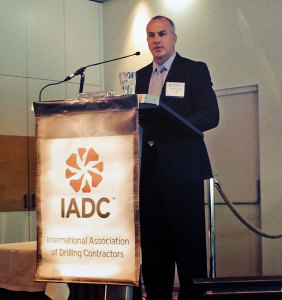BP looks to self-verification to strengthen procedural discipline
By Linda Hsieh, Managing Editor

Rules and procedures are present on every drilling rig, but how do you know if those rules and procedures are rigorously followed? To simply assume they’re being followed is, unfortunately, fooling yourself. “The best way to know is to go check,” Richard Osmond, Director S&OR, HSSE for BP’s Global Wells Organization, urged. Speaking at the 2014 IADC Drilling HSE Europe Conference in Amsterdam on 25 September, Mr Osmond explained a process for self-verification that is helping BP’s leaders to really know, not just assume, that procedures are being followed.
To strengthen its operational safety performance, BP last year conducted a deep analysis of two years of incident data from within BP and elsewhere in the industry. “A few key themes came out, but none as clear as the trend around the opportunity to improve the application and quality of procedures and risk assessments in our business,” Mr Osmond said.
As a result, BP launched an enhanced operational safety plan centered on improving procedural discipline. “We implemented a fleetwide engagement across our operations to strengthen our knowledge and management of our barriers and our discipline around well integrity and well control,” he said. Mr Osmond defined procedural discipline as the organizational commitment for everybody to do the job right, every time, through the rigorous use of procedures.
Key to this effort was ensuring that procedures are well understood by the workforce. A common comment from front-line employees is that the procedures don’t relate to the way in which the work is done. “Are your procedures clear and specifically designed with the end user in mind?” Mr Osmond asked. At one BP work site, a team of engineers, front-line leaders and equipment operators took ownership by forming a team to review and approve operating procedures.
“The procedures became much more accurate in the way they described the work that was conducted for the site, and they got used,” Mr Osmond explained. “They became shorter. They contained only the most important steps and details. They used photographs and multimedia instead of long text or drawings that the operators didn’t understand.”
Self-verifications were also implemented to systematically check that procedures are followed. Mr Osmond noted that these self-verifications do not replace inspections or audits, which continue to be conducted. “But we found the opportunity to go deeper and to be more systematic and to engage our front-line leaders.”
Unlike audits, self-verifications can be conducted much more frequently. “Most audit programs are conducted far too infrequently to give real insight around procedure use,” he said. They’re also largely conducted after the work is completed. “Therefore, the audit is largely forensic. It’s backward looking to see how you did compared to your requirements. It doesn’t sample enough work activity in the moment.”
For the self-verification process to be effective, it must occur at a minimum on a weekly basis, Mr Osmond said. They also must be conducted by line managers local to the rig or work site as part of their day-to-day job. “To accomplish this without severely overloading the front-line leader, these need to be frequent light touches – I’d say 30 minutes maximum for these self-verification activities.”
This year, BP’s Global Wells Organization equipped its well site leaders with a standard line of questions to ask during these self-verifications. They were developed around five key areas of process and personal safety. “This gives them the opportunity to keep small things small,” he said. “And to keep small things small, you have to spot them when they’re small. This frequent self-verification helps you to spot what I call drift. One day you may be in a good place; the next day, without checking, you won’t know whether you’ve drifted.”
Early results from the self-verification efforts have been encouraging, but Mr Osmond said more time would be required to sustain and see real benefits. “At BP we’re working in collaboration with our contractors and service providers to strengthen procedural discipline and self-verification across our industry. We believe this will further drive improvements and reduction of incidents or gaps of procedure use.”





Another interesting article Linda, thanks for sharing.
Currently I am researching and gathering data from industry on overarching critical Drilling & Rig operations integrity issues of today… and for this one I particularly like the idea of self-verification (to complement audits & inspections), and that the procedures need to have end users in mind (we’ve seen this sometimes unfortunately when they are written in an office – by someone who has never spent time on a rig or drilling/well site – and then sent to the field).
When drilling contractors and other operators have or adopt a similar framework, it may prove to be very beneficial on the front-line.
We have a saying, that may sum it up… “Trust, But VERIFY”